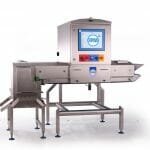The new Han® Gigabit Module from HARTING is the first modular industrial connector designed to meet the rail industry’s growing need for high-speed communication based on the Cat.7A cabling standard on-board rail vehicles.
The digitisation of the railway sector accelerated as cable-based communication in rail vehicles grows in response to WiFi usage, new developments in passenger information systems, and the use of additional sensors and assemblies for electronic monitoring and control. The growing volume of data is becoming increasingly important for the various players in the railway sector.
In order to meet the growing demand for communication on board trains, rail vehicles need powerful networks and interfaces that fit the specific requirements of the rail market. As one key requirement is high transmission speed, railway operators have decided on Cat. 7A as a future standard, allowing transmission in the frequency range up to 1 GHz.
The Han® Gigabit Module is the first matching modular connector to meet this requirement, offering signal integrity that is significantly better than the previous Cat. 6A standard. Shielding against interference also improves, as Cat. 7A cables consist of four individually screened wire pairs which are surrounded by another screen braid.
The new Han® Gigabit module enables Cat. 7A transmission in the train carriage area and offers advantages for interference resistance and frequency range. The
interface is shock and vibration resistant according to DIN EN 61373, Category II, which makes it suitable for extreme loads in the railway environment. The module is also future-proofed, allowing the installation of an Ethernet backbone for future facilities, upgrades and conversion of rail vehicles.
HARTING also supports flexible data exchange on the train with unmanaged switches and patch cables. In a chain comprised sensors, antennas, RFID readers and HARTING’s MICA® industrial computer platform – the latter serving as an Edge computer for filtering, aggregating and compressing the sensor data – ambient data can be recorded wirelessly in the periphery and digitally processed for control purposes. The MICA® platform translates the sensor data from the RFID reader and makes it available to other participants in the bus system in both filtered form and reduced to the required extent.
HARTING’s open hardware and software platform thereby promotes digitisation in various directions: here, the MICA® acts as an intermediary between the data protocols of manufacturers of independent systems.
Please click here for more information on the HARTING Han® Gigabit Module.
About HARTING
The HARTING Technology Group is one of the world’s leading providers of industrial connection technology for the three lifelines of Data, Signal and Power and has 13 production plants and branches in 44 countries. Moreover, the company also produces retail checkout systems, electromagnetic actuators for automotive and industrial series use, charging equipment for electric vehicles, as well as hardware and software for customers and applications in automation technology, mechanical and plant engineering, robotics and transportation engineering. In the 2016/17 business year, some 4,600 employees generated sales of EUR 672 million.
For further information visit www.HARTING.co.uk
About HARTING
The HARTING Technology Group is one of the world’s leading providers of industrial connection technology for the three lifelines of Data, Signal and Power and has 13 production plants and branches in 44 countries. Moreover, the company also produces retail checkout systems, electromagnetic actuators for automotive and industrial series use, charging equipment for electric vehicles, as well as hardware and software for customers and applications in automation technology, mechanical and plant engineering, robotics and transportation engineering. In the 2016/17 business year, some 4,600 employees generated sales of EUR 672 million.
For further information visit www.HARTING.co.uk








